Technical Analysis
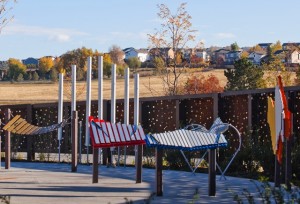
When choosing the equipment to install along the Karl Stirner Arts Trail, more had to be considered than simply what fit well in the area and the monetary budget. While keeping those aspects in consideration, we had to also analyze the current community setting and in what ways the addition of the musical playground will impact the KSAT and greater Easton community. An in-depth discussion of the community impact is discussed in the Policy Analysis, but suffice to say musical instruments maintain the theme of the KSAT and will involve the users of the trail in a more interactive manner than the current sculptures and pictures. We anticipate the musical playground will become a location to gather, contributing to efforts Easton has made in the recent years to build a stronger community infrastructure.
The Manufacturers
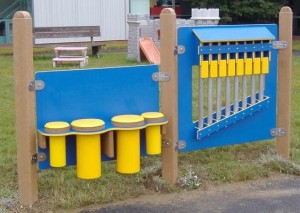
In order to keep with the art theme of the KSAT, the instruments chosen had to be both aesthetically and tonally pleasing. After searching, Freenotes Harmony Park, a Colorado based company, stood out because of its quality instruments that not only look professional grade, but also produce a rich and full sound. Since the KSAT Board specified the most important criteria as aesthetics, the group selected instruments from Freenotes Harmony Park because they present the most eye appeal, and per videos on their website, demonstrated the instruments have both a pleasing and appealing sound. Some manufacturers, such as The Meyer Design Group also manufacture musical playground equipment, but their products consist of drums and chimes attached to plastic walls and do not pose as striking an appearance as the Freenotes Harmony Park instruments. Schoolscapes also offers outdoor musical instruments, but their instruments look, aesthetically speaking, somewhere between those of The Meyer Design and Freenotes Harmony Park.

When people think of a playground, they often think of slides, swings, monkey bars, and the like. While a musical playground can resemble the traditional idea of a playground, those that do tend to lose musicality because the instruments chosen are oriented towards rough and tumble play as opposed to musical play. WonderWorx, a Colorado based company, offers a unique mix between the traditional playground equipment and musical playground equipment. Using the types of equipment found on a typical playground, the manufacturer designed their own versions of a swing and a seesaw to make music as the child plays. While we wanted to include some of the WonderWorx products in the plan because it would not only provide another outlet for the younger aged crowd, but also help bridge the popular idea of a playground with the musical playground, the products did not meet the aesthetic requirements. Decked out in bright yellows, bold blues, or olive greens, the instruments appear tacky and would have contrasted with the aluminum shine and more uniform colors of the Freenotes Harmony Park products.
Freenotes Harmony Park sells their instruments through distributors, the one for Easton, PA being General Recreation in Newtown Square, PA. To receive pricing for the Freenotes instruments, we contacted them, explained the project, and ran our ideas past them. Our representative is Steve Hemler, who will recognize the project by the keywords “Lafayette College,” “Bike trail,” “Freenotes Harmony Park,” and “Seth Kyler.” When ready to make the purchase, he can be contacted as shown below.
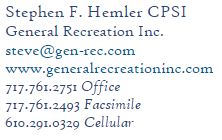
The Materials and Playground Infrastructure
Not much site maintenance is needed before installation of the instruments besides digging the holes for the instrument posts. Most instruments require holes at least 36” deep to go below the frost line and wary in diameter from 10” to 14” depending on the instrument. Some instruments, such as the Tuned Drums, require a trench 6” deep and 5’ by 2’ to secure the instrument bases with concrete. The installation requirements of each instrument vary, but Freenotes Harmony Park provides detailed instructions via the Spec Sheets/Install Info page on their website. These spec sheets can also be viewed by following the hyperlink attached to the name of each instrument. The spec sheets also specify how many bags of concrete are needed for the installation of each instrument, which again, varies from instrument. Most instruments need only 4 bags of concrete, but some of the larger setups, such as the Contrabass Chimes, require 18 bags of concrete.
After the instruments are installed and the concrete has dried, an artificial, raised stone border called Reversible Stone Landscape Timber with Spike will be set up around the perimeter of the playground to clearly designate the area. Manufactured by Child Works, these grey borders come in lengths of 4’ and are pinned together and into the ground with a 2’ spike. They are reversible with one side featuring rectangular, landscape stones and the other side rounded, river stones. Whoever installs the borders can decide which side to show. With a width of 5” and a height of 8”, the borders will surround the playground area and hold the foundation and compressed stone topping in place. Although compressed stone is not normally an appropriate safety surface for playgrounds, the instruments have no fall height, and therefore, a surface designed to soften the impact of a falling child is not needed. In speaking with Steve Hemler of General Recreation, the company through whom the Freenotes Harmony Park instruments will be purchased, he recommended the compressed stone as it is cheaper than bonded mulch and does not move around as much as regular mulch.
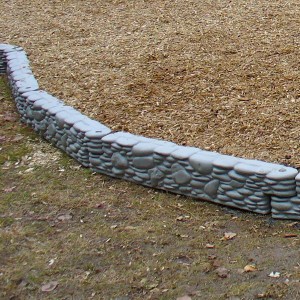

The most popular compressed stone, #57, is approximately 2” in diameter and can be commonly found in gardens, on paths, and other outdoor areas around houses. While the #57 compressed stone is more expensive than normal #57 stone, the compressed is better for walking and pathways as the stones will pack together, making it easier for walking or pushing a stroller over while still allowing for adequate water drainage. Only about 2” of compressed stone is needed, so the other 6” of surface depth can be filled with non-compressed stones or any other cheaper filler. If compresses stones were to be used as the only filler, the area, which is 1000 square feet, would require 28 tons of compressed stone as 1 ton covers about 150 square feet to a depth of 2” (How, n.d.).
Companies that manufacture outdoor musical equipment do so ensuring the instruments will withstand severe temperatures, snow, and ice. Freenotes Harmony Park manufactures their instruments out of polyester, powdercoated steel, and polycarbonate. Any plastic, which is used only in the drums, is recycled. For the instruments that require mallets, the mallets come tethered to a post with a nylon-coated, stainless steel cable. Occasional maintenance is recommended, but is easily done by anyone as it simply requires making sure the mallets are still attached to their respective posts and the instruments do not have dirt smears. Should any instrument require cleaning, the manufacturer recommends cleaning with soap and water, and, in the case of the aluminum chimes or keys, Goof Off – Heavy Duty Remover. Outdoor musical instruments are installed around the United States with great success, showing that the instruments do indeed withstand multiple seasons. Freenotes Harmony Park lists parks from California to Missouri to Pennsylvania that utilize their products, the closest one to Easton is located at The Crossing Abilities Playground in Mountain View Park, Tannersville, PA, about 30 miles north of Easton. A complete map of every Freenotes Harmony Park installation is available through their website.
The Instruments
Freenotes Harmony Park recommends choosing a minimum of three instruments and arranging them in a manner that allows players to maintain good eye contact with one another, encouraging interactive play. They offer a guide of their products, which specifies whether the instruments are percussive or sustaining, and their tone range (bass-alto-soprano). Percussive notes last for about one second whereas sustaining notes last for five or more seconds. Freenotes Harmony Park offers assistance in choosing instruments based on the size of the desired location, but their instruments require a space ranging from 1 ½’ x 3’ to 3’x 5 ½’ per instrument. From discussions with the KSAT Board, the musical playground must include chimes that resemble a fence so that children can run alongside them, striking them with their hands to create music. To ensure a variety of instruments and sounds, we decided to also include drums. Given these two criteria, we searched through the various instruments offered and considered a variety of combinations before selecting the final proposal.
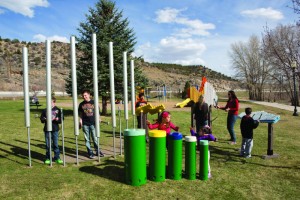
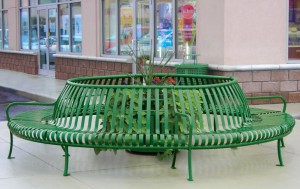
The proposed musical playground will include five different instruments surrounding a full, 360 degree, circular bench. Freenotes Harmony Park sells the Contrabass Chimes and Tuned Drums as part of a discounted package called The Premium Ensemble. Three other instruments come in the ensemble, the Imbarimba, the Pegasus, and the Swirl. Together, these five instruments make up an ensemble that includes a variety of vertical chimes, horizontal xylophones, and drums of varying heights, creating a myriad of different sounds and an atmosphere appealing to every age. To ensure the musical fence meets the ideals of the KSAT Board, a second set of Contrabass Chimes will be purchased and installed in line with the first set against the back of the playground. Arrangement specifications show the instruments need at least a 15’ diameter circle in which to be installed with proper spacing between instruments. As the intended locations is 40’ deep by 25’ wide, there is more than enough room for the ensemble and extra chimes. Belson Outdoors sells the bench in a variety of colors, of which we recommend black, and weights 1,120 pounds. In the hole surrounded by the bench, a tree should be planted.
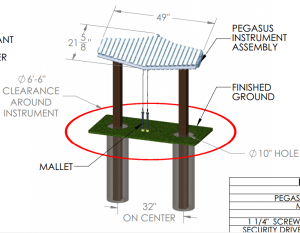
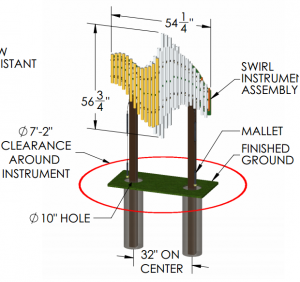
Spacing
The total area of the plot is 1,000 square feet, a rectangle 25′ wide by 40′ deep. This is ample room for the recommended layout, which is shown in Figure 27.
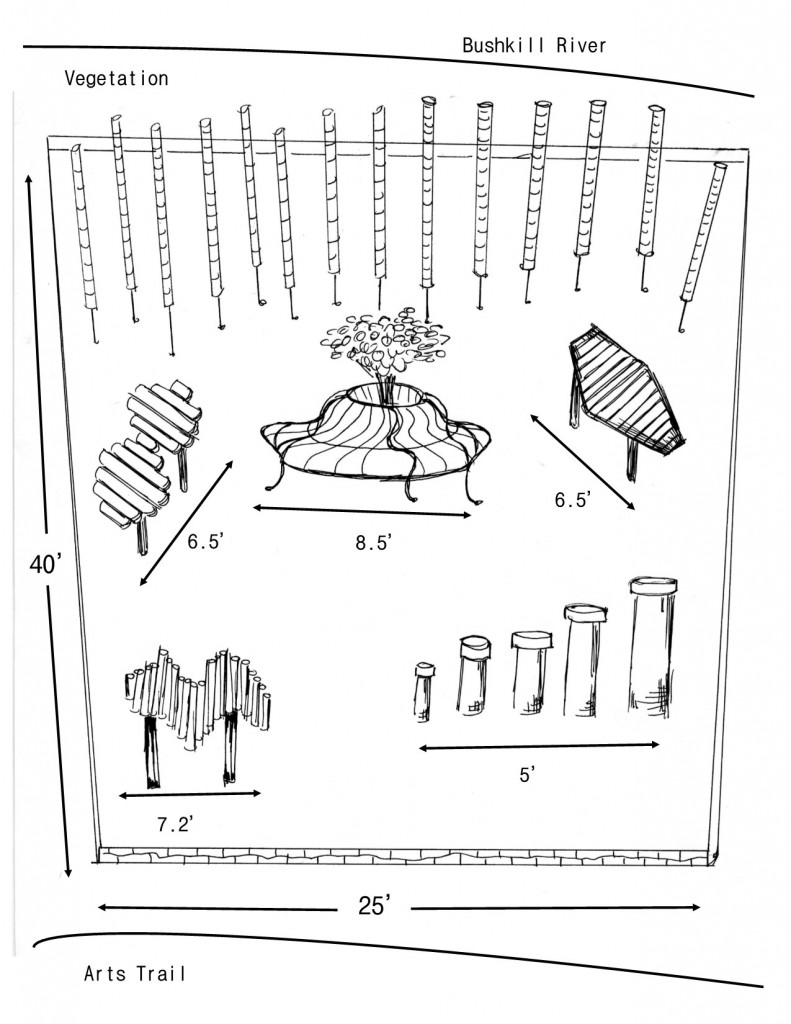
In the center of the playground will be a circular metal bench where parents and other visitors can sit and rest, enjoying the sights and sounds of the space. The dimensions of the bench, as indicated in Figure 28, are 2′ 8″ in height, 8′ 6″ in total width, with a 4′ diameter inside circle.
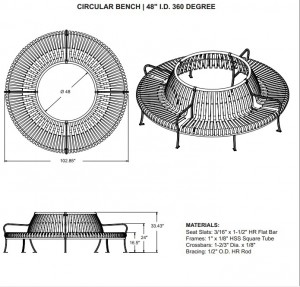
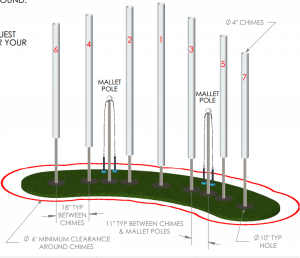
Next, as shown in Figure 29, Contrabass chimes will frame the back wall of the playground, blocking visitors from the vegetation and river below. The chimes come in a set of 7, so we will order two sets to adequately create the desired barrier. Through calculations we found that the 14 chimes and 4 mallet poles will need 25 feet along the back wall of the playground. The chimes can be arranged in any format from a straight line to an S-shape. To help form the playground, we recommend a slightly concave line, the chimes curving in towards the playground and KSAT. Regulations specify that each chime should be 18″ apart from one another. As shown in Figure 29, each chime has a 4″ diameter with 11″ needed between the chimes and mallet poles. Additionally, there should be a 6′ clearance around the entire chime assembly. Because we only want people to use the front side of the chimes as the chimes are meant to frame the inside of the playground, a 6′ clearance is only necessary on the playground side of the chimes.
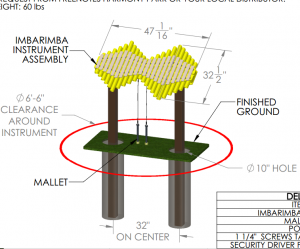
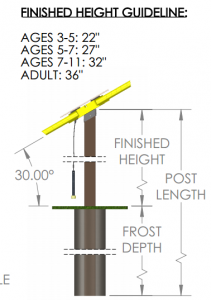
Since the instruments are different sizes and require different clearance areas, the arrangement had to ensure there was adequate spacing between the various fixtures. We suggest putting Imbarimba in the back left corner of the playground. The Imbarimba, a pentatonic instrument made of fiberglass bars combining the elements of a resonated xylophone and thumb piano that sounds like a gong, requires a 6′-6″ clearance around the instrument, which has a width of almost 4′ and a depth of 2′ 8″. It’s stock color is yellow. The Pegasus, which comes in sky blue, is made of 23 resonated aluminum bars in the key of C Major and A Minor that resonate like a gong. It will be installed in the back right corner of the playground. A 6′-6″ clearance is required around the instrument, which has a width of 4′ 1″ and a depth of 1′ 10″. In the front left corner is The Swirl, which produces pure, soothing tones from its resonated anodized aluminum chimes that range from soprano to alto. It comes in orange and requires a 7′-2″ clearance around its 4′ 6″ vertical body. As The Swirl stands upright, the width is negligible and therefore not listed. Figure 31 shows the recommended finished height guidelines for the Imbarima, with different heights specified for different age groups. We suggest using the height guidelines for ages 7-11 as this height of almost 3′ will cater to children and adults alike. The Swirl and Pegasus can also be assembled at varying heights, so the instruments could be assembled at different heights to cater to all ages. For examples, the Pegasus could be assembled at the appropriate height for ages 5-7, the Imbarimba assembled at the appropriate height for ages 7-11, and the Swirl assembled at the appropriate height for adults. The final heights do not particularly matter and it ultimately comes down to a matter of preference. We recommend assembling all the instruments at the appropriate height for the 7-11 age group as this would be sufficient in catering to all ages, only requiring those very short or tall to either stretch or bend. To promote eye contact and interaction between participates playing the instruments, they should be installed so that the person playing is facing the center bench.
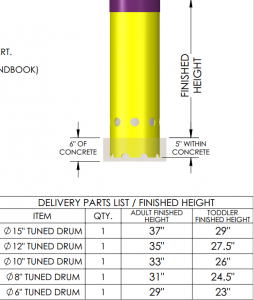
Lastly, in the front right corner we suggest putting Tuned Drums. Though the drums can come in two color schemes, we suggest choosing the rainbow color scheme for its colorful aesthetic appeal. As Figure 33 shows, the 5 drums each have a different diameter of 15″, 12″, 10″, 8″ or 6″. To keep from children’s heads from getting stuck in-between the drums, Freenotes Harmony suggests putting the drums either less than 3″ apart or more than 9″ apart. Our plan has the drums spaced out 10″-12″ apart, both to ensure that children’s heads do not get stuck and to allow for children to gather around and between the drums. Figure 32 shows the adult and toddler recommended heights for each drum. Since the other instruments will be installed at a height higher than that recommended for toddlers, we suggest implementing the toddler height here, on the drums, to include a component of the playground more specifically geared towards the very young.
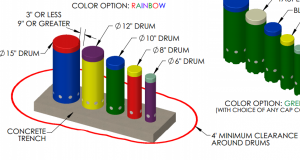
Conclusion
Using the proposed arrangement, these five instruments and circular bench will fit nicely into the space allocated for the musical playground. With everything combined together, the environment created will be one that promotes musical participation and social interaction. Steve Hemler, the General Recreation contact, described the instruments as easy to install, so once purchased, the engineering class should have little difficultly beyond lifting the bags of cement, especially as the instruments come with detailed instructions.
To read about the economic analysis involved in implementing a musical playground on the Karl Stirner Arts Trail, follow the link to the Economic Analysis.
